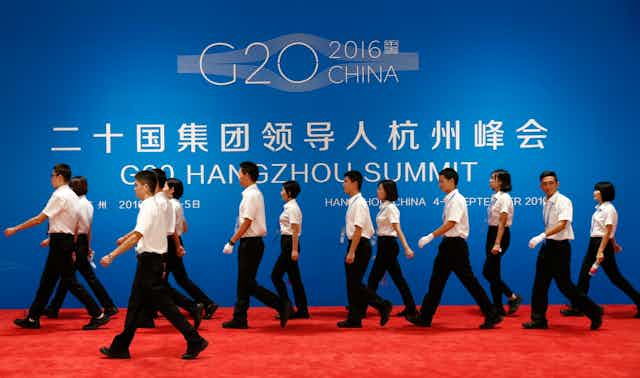It’s essential that the G20 leaders push for adoption of the World Trade Organization’s Trade Facilitation Agreement (TFA) at the summit meeting in Hangzhou, China, in the face of growing anti-globalization forces. This agreement could be the tipping point to highlight the importance of global free trade and prevent a revival of true protectionism in the form of increased tariffs and other barriers to trade.
A year ago it looked like the constituency in favor of globalization was continuing to dominate the policy sphere, in spite of the failure of the Doha Round of multilateral trade talks, as new and larger free trade agreements were being negotiated. These have included the 12-country Trans-Pacific Partnership (TPP), the Trans-Atlantic Trade and Investment Partnership (TTIP) between the U.S. and the EU and the 16-country Regional Comprehensive Economic Partnership (RCEP) centered on Asia, particularly China.
Since then, although the TPP negotiations were successfully concluded, the prospects for the U.S. ratifying it are increasingly dire as both members of Congress and presidential candidates oppose it. For various reasons, some similar and some not, the prospects for concluding the TTIP are also receding. This is in part because of the absence of the U.K. from the EU negotiations due to Brexit, which itself has been yet another symptom of globalization discontent.
The TFA agreement is already well on its way toward acceptance by the required two-thirds of WTO members, but a strong statement in support of it by the G20 leaders would endorse the liberal trade regime that has contributed so much to prosperity over the last 70 years.
There is growing discontent with various aspects of globalization, including not just trade but also international investment and the reach of multinational corporations. Many perceive these forces, increasingly permitted by trade agreements such as the North American Free Trade Agreement (NAFTA) and the expanded membership of the WTO, to have destroyed jobs in the developed world, thus increasing unemployment and lowering wages.
Economic analysis suggests that much of this concern is misguided, but not all. The effects of NAFTA, widely condemned by some political candidates and others, were in fact on balance positive, and any disruptions due to NAFTA were small compared with other changes affecting the labor market. But greatly expanded trade with China, the host of this year’s G20 meeting, has been much larger and more disruptive than trade due to NAFTA or any other trade agreement.
Critics point to China’s accession as member of the WTO in 2001 as causing this, even though that event did not in fact reduce, for example, U.S. tariffs on Chinese exports.
The TFA was the first successful multilateral agreement ever achieved by the WTO, with negotiations concluded at the WTO Ministerial Meeting in Bali, Indonesia, in December 2013. Against the backdrop of the more ambitious Doha Round of negotiations that had been ongoing since 2001 and that came to an unsuccessful conclusion two years later, the TFA demonstrated that the WTO could be a viable forum for multilateral negotiations.
This promise was fulfilled again at the Nairobi Ministerial in December 2015 with another agreement to abolish export subsidies for farm exports, among other commitments. This agreement, like the TFA, is of particular importance for removing obstacles to the success through trade of developing countries.
The TFA, as its name suggests, is about permitting trade to take place more easily, cheaply and quickly. It provides for cooperation among customs authorities to coordinate and speed up customs clearance.
It promises to reduce the paperwork and bureaucratic delays that hinder and sometimes completely block trade, especially in time-sensitive products. And perhaps most important, it includes commitments by wealthier countries and institutions to provide technical assistance and capacity building in this area, something that many are already now doing in response to the TFA even prior to its formal adoption.
Trade facilitation was one of the many objectives that were on the agenda of the Doha Round. It was arguably the least controversial of these objectives, since it was hard for anyone to argue, unless their incomes derived directly from impeding trade, that it was not both needed and beneficial to the world economy in general and to developing countries in particular.
Nonetheless, reaching agreement on the TFA was not a trivial accomplishment, in part because it was used by some parties as leverage for pushing other agendas. These other issues may well have been equally desirable but were more controversial, and as a result the actual adoption of the TFA was delayed almost a year until November 2014. That triggered the process in which members of the WTO need to complete their individual domestic ratification processes. Once two-thirds of the WTO membership have done that, the TFA will enter into force.
As of now, 92 WTO members have done so, just 18 short of the 110 needed. Most G20 members are included in that 92, but four are not. No doubt these four will complete the process without the prodding of their G20 colleagues, but an explicit push by the G20 would nonetheless give a strong signal of support for trade and the WTO to the world at large.

